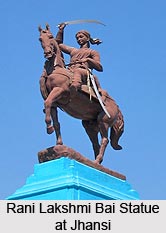 Located in the Jhansi district of the northern state of India, Uttar Pradesh, the city of Jhansi is situated between the rivers Pahunj and Betwa. It is the administrative headquarters of the Jhansi district and the Jhansi Division. The original walled city grew up around its stone fort, which crowns a neighbouring rock. The ancient name of this historical city was Balwantnagar.
Located in the Jhansi district of the northern state of India, Uttar Pradesh, the city of Jhansi is situated between the rivers Pahunj and Betwa. It is the administrative headquarters of the Jhansi district and the Jhansi Division. The original walled city grew up around its stone fort, which crowns a neighbouring rock. The ancient name of this historical city was Balwantnagar.
History of Jhansi
In the 9th century, Jhansi was ruled by the Rajput Chandella dynasty of Khajuraho. At that time Jhansi was a part of the regions of Chedi Rashtra, Jejak Bhukit, Jajhoti and Bundelkhand. Jhansi developed around a fort built in 1613, which became a strong centre in 1742. In the 18th century the town of Jhansi served as the capital of a Maratha province and later the Princely State of Jhansi from 1804 till 1853 when the territory became a part of British India. During the British rule, Jhansi rose to prominence, as it was one of the centres where the outburst of the 1857 Sepoy Mutiny took place. Since then Jhansi has been the symbol of courage, self-respect and bravery. It is the land of Rani Lakshmi Bai, the brave woman-ruler of Jhansi, who fought the British. After independence, Jhansi became a part of the Uttar Pradesh. A new dimension has been added to this historic city with the introduction of the Jhansi Festival, held every year between the months of February to March. It offers a fine opportunity to enjoy the arts, crafts and culture of the region.
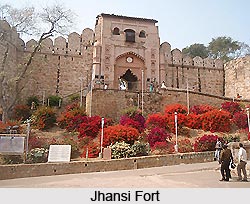 Demographics of Jhansi
Demographics of Jhansi
According to the 2011 census, Jhansi has a total population of 19, 98, 603 out of which the male and female were 1, 057, 436 and 941, 167 respectively; its urban agglomeration is a population of 8, 30,311. Jhansi city has 85th rank among the most populated cities of India, according to the 2011 census. The literacy rate of Jhansi is 63.81 percent, which is much lower than the national average.
Climate of Jhansi
The topography of Jhansi consists of undulating terrains which has vast mineral deposits. The city lies on the south western border of the vast terrain plains of Uttar Pradesh. The land of Jhansi is favourable for the cultivation of citrus fruits. The main crops grown here are wheat, pulses, peas and oilseeds. Located on a rocky area, Jhansi faces extreme temperatures. During the summer months the mercury rises as high as 47 degree Celsius during the day time and sometimes drops as low as 4 degree Celsius during the winter months. The rainy season starts in the mid week of June and starts weakening in September. At present Jhansi is a major centre of trade and industries, which are mostly railway workshops and iron and steel mills. There are many manufacturing units of brassware, rugs, rubber and silk goods.
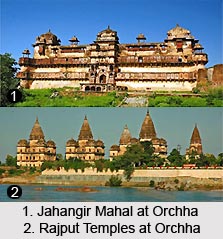 Places to Visit in Jhansi
Places to Visit in Jhansi
Jhansi is a cultural city mainly famous for its cultural tourism. There are many forts and palace in the city that one can explore unusual from the regular shopping malls and crowded markets. Apart from the forts, there are also many other tourist places in Jhansi that one can explore.
Jhansi Fort: One of the main tourist attractions of the city is the Jhansi Fort. It is one of the oldest forts in Jhansi, and was built by Raja Bir Singh Judao in 1627 and has strategic importance since the earliest times. The Jhansi Fort is a living testimony of ancient glamour and valour also has a fine collection of sculptures which provide an excellent insight into the eventful history of Bundelkhand.
Government Museum: This museum is another popular tourist attraction and is centrally located within the city and is visited by many. The Government Museum contains a rich collection of ancient sculptures, statues and war relics. The museum has a fine collection of terracotta, bronzes, weapons, manuscripts, paintings and coins of gold, silver and copper.
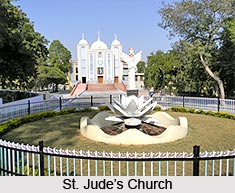 Rani Mahal: Rani Mahal also known as the Queen`s Palace was built by Raghunath II of Newalkar family in the year 1796. It is located in heart of city near to Jhansi fort. The palace is embellished with multi coloured art and paintings on its walls and ceilings. Currently, the palace has been converted into a museum and has a massive collection of sculptures between the periods of 9th to 12th century A.D.
Rani Mahal: Rani Mahal also known as the Queen`s Palace was built by Raghunath II of Newalkar family in the year 1796. It is located in heart of city near to Jhansi fort. The palace is embellished with multi coloured art and paintings on its walls and ceilings. Currently, the palace has been converted into a museum and has a massive collection of sculptures between the periods of 9th to 12th century A.D.
Mahalaxmi Temple: This temple was built during the 18th century and is mainly devoted to Goddess Mahalaxmi. The Mahalaxmi Temple is quite famous and is visited by many devotees every year.
Orchha: It is a town in Madhya Pradesh which is 14 km from Jhansi city. Situated next to bank of river Betwa this town can be called a photographer`s delight. It is full of architectural ruins, a village and a small market. Places to see here are fort, Jahangir Mahal, Sheesh Mahal.
Gwalior: The city of Gwalior is famous for forts, palaces and tombs, which are all beautifully architected. There is a lot to explore in this city which is a major city between Jhansi and Agra. Among tourist attractions are- Rani Lakshmi Bai`s memorial, Jayavilas palace and museum, fort, Tansen`s tomb, Phoolbagh, etc.
Barua Sagar: Barua Sagar, around 24 km from Jhansi, is a small town situated on the bank of Betwa River and is named after a large lake called the Barua Sagar Tal. This lake was created about 260 years ago when Raja Udit Singh of Orcha erected the embankment. A fort was also built by him and the ruins of the two old Chandela Temples, made of granite, are on the north-east side of the lake. The older one is called Ghughua Math and nearby is the later Gupta period temple called Jarai-Ka-Math. This is dedicated to Lord Shiva and Devi Parvati.
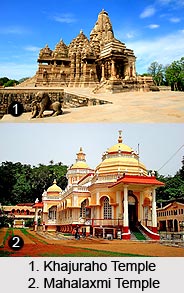 St Jude"s Church: This shrine of great importance among Catholic Christians, St. Jude`s bone is buried in the foundation of the cathedral. Devotees come from as far as Goa, on the annual St Jude`s feast day on October 28th. Feast day is marked by a weeklong fair and a procession on the last day of the fair. This fair attracts people of all the faiths and religions.
St Jude"s Church: This shrine of great importance among Catholic Christians, St. Jude`s bone is buried in the foundation of the cathedral. Devotees come from as far as Goa, on the annual St Jude`s feast day on October 28th. Feast day is marked by a weeklong fair and a procession on the last day of the fair. This fair attracts people of all the faiths and religions.
Parichcha Dam: Built on the Betwa River near Parichcha town which is about 25 km from Jhansi on the Jhansi-Kanpur National Highway No. 25. The Parichcha Dam reservoir is a placid stretch of water that runs to Notghat Bridge, 34 km away from Jhansi and is ideal for water sports.
Visiting Information on Jhansi
Jhansi is a junction on the Mumbai-Delhi route and is well connected by an excellent railway network. The nearest airports are Gwalior and Khajuraho at a distance of 103 km and 175 km and via roadways Jhansi are easily accessible by the National Highway 25 and 26.



















